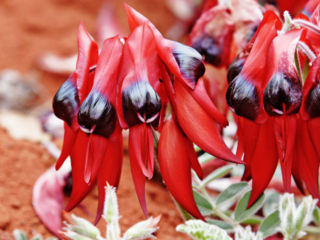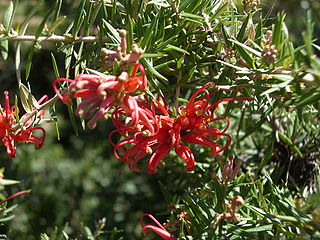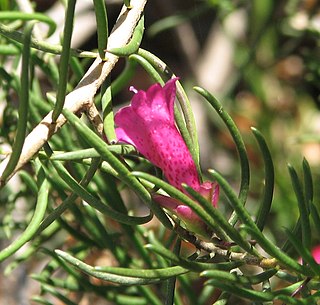
Swainsona formosa, Sturt's desert pea, is an Australian plant in the genus Swainsona, named after English botanist Isaac Swainson, famous for its distinctive blood-red leaf-like flowers, each with a bulbous black centre, or "boss". It is one of Australia's best known wildflowers. It is native to the arid regions of central and north-western Australia, and its range extends into all mainland Australian states with the exception of Victoria.

Myoporum is a genus of flowering plants in the figwort family, Scrophulariaceae. There are 30 species in the genus, eighteen of which are endemic to Australia although others are endemic to Pacific Islands, including New Zealand, and one is endemic to two Indian Ocean islands. They are shrubs or small trees with leaves that are arranged alternately and have white, occasionally pink flowers and a fruit that is a drupe.

Dicentra formosa is a flowering plant with fern-like leaves and an inflorescence of drooping pink, purple, yellow or cream flowers native to the Pacific Coast of North America.

Banksia paludosa, commonly known as the marsh or swamp banksia, is a species of shrub in the plant genus Banksia. It is native to New South Wales, Australia, where it is found between Sydney and Batemans Bay, with an isolated population further south around Eden. There are two recognised subspecies, the nominate of which is a spreading shrub to 1.5 m (5 ft) in height, and subsp. astrolux is a taller shrub to 5 m (16 ft) high found only in Nattai National Park.

Lechenaultia is a genus of plants in the family Goodeniaceae. Some species of this genus are used as ornamental plants, in particular L. biloba, L. formosa and L. macrantha.Lechenaultia species are diverse in form: they may be woody or herbaceous, upright or prostrate with leaves flat, needle-like or virtually absent in mature plants. The genus differs from other Goodeniaceae in the structure of the stigma and the fertilization mechanism. They are found in Australia and New Guinea.

Grevillea juniperina, commonly known as juniper- or juniper-leaf grevillea or prickly spider-flower, is a plant of the family Proteaceae native to eastern New South Wales and south-eastern Queensland in Australia. Scottish botanist Robert Brown described the species in 1810, and seven subspecies are recognised. One subspecies, G. j. juniperina, is restricted to Western Sydney and environs and is threatened by loss of habitat and housing development.

Eremophila alternifolia, commonly known as narrow-leaved poverty bush, is a plant in the figwort family, Scrophulariaceae, and is endemic to areas between the far west of New South Wales, the far south of the Northern Territory and the southern half of Western Australia. It is a variable shrub, with respect to its growth form, leaf shape and flower colour. Aboriginal Australians used the leaves to treat ailments such as colds and skin infections and pharmacological testing has shown that the leaves contain compounds that affect cardiac activity.

Leucophyta is a plant genus which is endemic to Australia. The genus was first formally described by botanist Robert Brown in 1818.

Lechenaultia biloba, commonly known as the Blue Leschenaultia, is a plant in the family Goodeniaceae native to Western Australia. It was described in 1839 by John Lindley. The species name refers to the two corolla lobes of the flowers. It is a very variable species.

Lambertia formosa, commonly known as mountain devil, is a shrub of the family Proteaceae, endemic to New South Wales, Australia. First described in 1798 by English botanist James Edward Smith, it is the type species of the small genus Lambertia. It is generally found in heathland or open forest, growing in sandstone-based soils. It grows as a multistemmed shrub to around 2 m (7 ft) with a woody base known as a lignotuber, from which it regrows after bushfire. It has stiff narrow leaves, and the pink to red flowerheads, made up of seven individual tubular flowers, generally appear in spring and summer. It gains its common name from the horned woody follicles, which were used to make small devil-figures.
George Maxwell (1804–1880) was a professional collector of plants and insects in Southwest Australia. The botanical specimens he obtained were used to make formal descriptions of the region's plant species.

Acacia truncata, commonly known as the angle leaved wattle or west coast wattle, is a coastal shrub in the family Fabaceae, with a native distribution along the southwest coast of Western Australia. A specimen of this wattle was part of an early European botanical collection, perhaps the first from Australia.

Acacia myrtifolia, known colloquially as myrtle wattle, red stem wattle or red-stemmed wattle, is a species of Acacia native to coastal areas of southern and eastern Australia.

Scaevola aemula, the fairy fan-flower or common fan-flower, is a small shrub in the family Goodeniaceae, native to southern Australia. It grows to 50 cm in height and produces white or blue flowers in spikes up to 24 cm long from August to March in its native range. These are followed by rounded, wrinkled drupes to 4.5 mm in length.
Lechenaultia macrantha is a species of low growing plant found on sandy or gravelly soils in Western Australia.

Astroloma humifusum, commonly known as the native cranberry or cranberry heath, is a small prostrate shrub or groundcover in the heath family Ericaceae. The species is endemic to south-eastern Australia.

Persoonia falcata, commonly known as the wild pear, is a shrub native to northern Australia.

Lomatia tinctoria, commonly known as guitar plant, is a shrub to about 2 metres tall of the family Proteaceae. It is one of three species of Lomatia endemic to Tasmania, the others being L. polymorpha and L. tasmanica. Lomatia tinctoria is closely related to L. polymorpha, with which it sometimes hybridises. Its leaves are divided, while those of L. polymorpha are simple.

Stenanthera is a genus of flowering plants in the family Ericaceae. Most are low shrubs with leaves that are paler on the lower surface, tube-shaped flowers and with the fruit a drupe. There are three species, formerly included in the genus Astroloma.

Persoonia terminalis, also known as the Torrington geebung, is a rare shrub belonging to the family Proteaceae, and native to northern New South Wales and southern Queensland in eastern Australia. Reported as a subspecies of Persoonia nutans in 1981, it was described as a species by Lawrie Johnson and his colleague Peter Weston in 1991.


















